|
FAQs about the Diseases of
Clownfishes
20
Related FAQs: Clownfish Disease 1, Diseases of Clownfishes 2, Diseases of Clownfishes 3, Clownfish Disease 4, Clownfish Disease 5, Clownfish Disease 6, Clownfish Disease 7, Clownfish Disease 8, Clownfish Disease 9, Clownfish Disease 10, Clownfish Disease 11, Clownfish Disease 12, Clownfish Disease 13, Clownfish Disease 14, Clownfish Disease 15, Clownfish Disease 16, Clownfish Disease 17, Clownfish Disease 18, Clownfish Disease 19, Clownfish Disease 21, Clownfish Disease 22, Clownfish Disease 23,
Clownfish Disease 24,
Clownfish Disease 25,
Clownfish Disease 26,
Clownfish Disease 27,
& FAQs on
Clownfish Disease By: Environmental
Stress, Nutrition, Social/Behavioral/Territoriality, Trauma/Mechanical Injury, & Pathogens:
Lymphocystis, Infectious Disease (Bacteria, Fungi...),
Protozoans: Cryptocaryon/Ich,
Amyloodinium/Velvet, Brooklynella (see article below), &
Mysteries/Anomalous Losses, Cure, Success Stories, & Clownfishes in General, Clownfish Identification, Clownfish Selection, Clownfish Compatibility, Clownfish Behavior, Clownfish Systems, Clownfish Feeding, Clownfishes and
Anemones, Breeding Clowns,
Related Articles: Clownfish Disease, Clownfishes, Maroon
Clowns, Marine Disease,
Brooklynellosis,
|
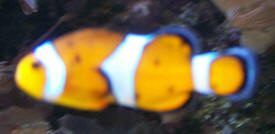
|
|
Sick Clownfish 7/6/08 Please help! We
have a saltwater tank that has been running over 2 months now and
is successful with hermit crabs, turbo snails and cleaner shrimp.
We have introduced clownfish and our first 3 have died and it
appears our 4th one is going too. <!?> We have a 45 gallon
tank and all our levels are in spec per our testing kit. The last
2 clownfish that died started by having breathing trouble
(rapid/gasping) and the last one developed a black splotch above
his left eye which grew bigger and he eventually died. This last
fish seemed perfectly healthy and has been doing fine, but
started gasping a few days ago and has now developed the same
blackish splotch above his left eye. We have been oxygenating the
water every week. We don't want to lose any more fish. Can
you please help us determine what's wrong with him? <Mmm,
yes... assuredly. This will take a bit of reading on your part.
Some going back and forth twixt ourselves... But we can/will
solve> We also have chromis and a watcher goby that seem to be
fine. Another clownfish is also in the tank and doesn't seem
to exhibit any of these issues, but neither did this sick one,
until now. Thanks, Diana <"Something" is amiss
here... perhaps chemical (though the invert.s living is testimony
in many ways otherwise...), or biological/pathogenic. Are these
Clownfish wild-caught? Or, tank bred and reared? Please ask your
dealer re... and begin perusing here:
http://wetwebmedia.com/marine/fishes/part2.htm The last tray at
the bottom. Bob Fenner>
Re: Sick Clownfish 7/7/08 Thanks for your
response. My husband has said that these have been wild-caught
Clownfish as per the store. <A poor choice... as you're
learning> We got them at a reputable dealer called Big
Al's here in Toronto. I have attached 2 pictures (the best I
could get of the little guy as he tends to stay there and not
really move). The splotch is over his left eye and slowly grows
bigger. On the last one that had a similar splotch, it grew over
the whole left side of his head while he had more and more
trouble breathing (bigger gasping/labouring). I have read a lot
on your site, but nothing seems to match the issues we are
experiencing. <Au contraire! Likely this is Brooklynellosis
and gill flukes... too common...> It almost appears to be some
sort of hemorrhaging. Any additional help you can offer would be
greatly appreciated. Losing these little guys is breaking my
heart and we can't figure out why! <Read on. BobF>
|
|
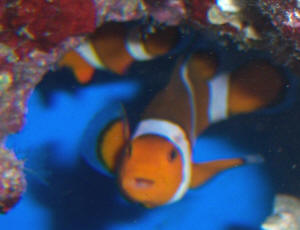 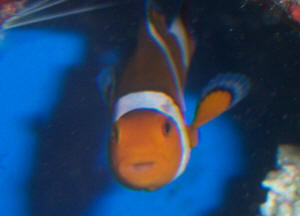
|
|
Urgent very worried about clowns, need data
6/30/08 Sorry to email you again but I'm desperately
worried about my two false Percs. This morning they are shooting
round the tank, swimming mostly at the surface and one is pale
(they're black/white colour morphs). I tested ammonia etc
last night and all came back fine (ammonia and nitrite 0, nitrate
<5ppm, dKH 12.5-12.8). <There is more to water quality,
habitat suitability than these for sure> I've done an
emergency water change <Good> (they are in a 70l nano with
moonlights on for a few hours morning and evening) and have
changed approx. 5% of the water, they seem to be a little less
stressed but I'm really worried what has caused this and what
I must do now to help them. <Me too> Any help and advice
you can give would be great, I've had these little guys for a
few months with no problems and I can't bear to lose them.
Carolyn <... need to know more re the system, history, maint.,
other livestock to begin guessing here... Bob Fenner>
Re: urgent very worried about clowns 6/30/08 HI
Bob, <Carolyn> Many thanks for the reply. The system is a
70l nano running a skimmer (on all the time) and 20x total tank
volume circulated every hour. The tank's occupants are the
two clowns, a mandarin, one skunk cleaner shrimp and assorted
sort corals and Zoas (all frags). The system has been running
since new year 2008, first livestock added after 8 weeks cycling
(no detectable ammonia or nitrite for 3 weeks prior to adding any
livestock). I do a 5% water change every 4 days making sure the
water is temp/pH matched to the tank water before adding, ammonia
nitrite and nitrate are measured every 3 days (am aware this is
still a young system), calcium and magnesium are checked weekly.
The only addition I use is the Salifert all in one and only then
when calcium/dKH or magnesium need replenishing. Prior to today
the clowns have had T5 lights on from 10am to 8pm, moonlights
going on at 8pm-12am, then again 8-10am, however this morning my
partner turned them on manually at 5.30am (!) - could this shock
have upset them? <Mmm, a bit... if it was otherwise very dark
outside their system> The only other factor I can think may be
involved is that I've noticed an algae bloom on the glass
which returns almost as soon as its cleaned away and spots of
Cyanobacteria appearing which we haven't seen since the tank
cycled. <This, these can definitely be problematic...
toxic> Not sure if this is the cause or simply a symptom of
the problem, however the T5's are due to be replaced so am
doing that today. Sorry for the long message - we're
currently in the process of moving house so the clowns will be
moved to their new permanent home (a 110 gallon system) in the
next couple of weeks but I want to sort this before the move for
obvious reasons. Many many thanks, Carolyn <Let's hope all
settles in/down. Bob Fenner>
|
Sick Baby Clown, reading 6/25/08 I brought two baby
clowns (false Perculas) three days ago. Each are about 4 weeks to 6
weeks old. <? Very young> Unfortunately, when I brought them home
and started acclimating them to quarantine I noticed the bigger one had
something weird covering its tail. Like some sort of white slime. The
tip of the tail was split into little strands. His body is darker than
the other clown fish and has a dark spot around the head. As for
behavior, he stays pretty much in a corner in the tank near the ground.
<Bad signs> Never goes away from the ground. He seems as if he
was eating from the ground but he is not (at least not to my
knowledge.) This makes feeding him a lot harder. What could be wrong
with him and what kind of medication can I give him? Any particular
foods that baby clowns will eat? <Live baby brine at this size...
Read here: http://wetwebmedia.com/marine/fishes/part2.htm toward the
bottom... Bob Fenner>
White stringy feces. Clown dis., Flagyl use 6/25/08 I
got another question for the experts. <Got? Experts?> I have a 75
gallon FOWLR with the following livestock: yellow tang, asfur angel,
<Needs MUCH more room than this> blue flasher wrasse, 2
clownfish, and some snails. The clownfish has recently shown to have
white stringy feces. <Mmm, how long have you had this fish? Was it
wild-collected (vs. captive produced)?> I have tried Prazi-pro but
it has not resolved the issue. It is safe to use Metronidazole soaked
foods or a product like Jungle's Anti-Parasite Medicated Fish Food
in the main tank? <Mmm, yes... safe enough IMO. Please read re this
symptom in Clownfishes, the use of Metronidazole on WWM for further
input, cautionary remarks. Bob Fenner> thanks, L
Black Spots on Clown Diagnosis -- 06/02/08 Good
Morning/Afternoon/Evening, <And to you> I have a False Perc
in a 29G All-In-One. He¹s been hanging out for over a
year and a half and has had excellent health. He is the only fish
inhabitant. He took a liking to the Candy Cane LPS I put in around
a year ago and generally sleeps between one of the heads and the
rock every night along with just buzzing around the tank most of
the day and occasionally, rubbing the CC. He really enjoys swimming
in the jet of the powerhead. His diet consists of mysis and
Formula-2 flake food. I give him mysis twice a week and Forumla-2
twice a week. I have attached a picture of some black
³dirt² spots that have shown up more
recently. I always remember him having some small spots but they
seem to have gotten more numerous. I cannot find any exact match of
the spots on any search other than it could be ³Black
Ich² <Mmm, no> but he doesn¹t really
display any of the symptoms (he has been and continues to be
perfectly normal). Should I attempt to follow any treatment for him
at this point or continue on unless he starts showing any other
symptoms? Other tank inhabitants are various Corallimorphs, GSP,
some hermits, a fighting conch (yeah I know but he sure is cool to
watch), and various snails, and a sand flea (filter feeder under
the sand, very fascinating). <Neat!> Water is changed
20% every 10 days with distilled water and Oceanic sand. I run
carbon and Phosban to assist the biological filtration. I attached
a pic but I don¹t believe it is of much use. They are
very tiny spots. Thanks Chris <I don't think these markings
are anything to really worry re... they're very likely
melanophores (color cells) showing/expressing from contact with the
stony coral. I do want to mention that if it were mine, I'd add
another Percula... Bob Fenner> Re: Black Spots on Clown
Diagnosis -- 06/02/08 Thank you for answering my question and
the format in which you provide knowledge to everyone. It is a
great service for all who want to learn versus being told. We all
have a fiduciary responsibility to all that we keep. Chris
<Ah, welcome Chris. We are in agreement. Cheers, BobF> |
|
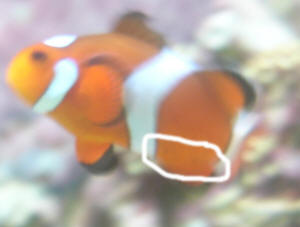
|
Bad beginnings.., Sick Clowns
5/24/08 Hello, <Hi> I have a QT tank running with two
juvenile false Percula fish. The bigger one of the two was just added
about three days ago to the QT tank and the little one has been for
about 5 days. I was having a little trouble feeding the little one when
I first brought since it only took small bites that I brought live
brine shrimp and began feeding them this food. The second day the
bigger one was swimming abnormally. Like a little titled to the side
staying near the ground and sometimes even putting his head down tail
up. Seeing how this was right after I feed them live brine shrimp I
thought that it was a swimming bladder problem. <Odd swim patterns
are pretty common with clownfish, and are normal.> Than today he has
stayed the entire day with the little one in a front corner of the tank
laying on the ground. I feed them food and they will not get out of the
corner. So, I got my net and tried moving them out of the corner and
only the little one stayed away while the big one returned. <Not a
good sign.> I have no idea what is wrong with him besides that
bladder problem. I was thinking maybe since all the quarantine tank had
to hide was two pieces of pipes that together that maybe they stayed
their because of stress or to protect each other. By the way, water
parameters are normal. <Numbers please, most likely these symptoms
are environmental in nature.> Please give me some advice. I really
don't want the big one to die. He was the replacement of another
juvenile smaller false Percula that was sick before I brought him in
the tank and died before I could find out what he had. These were my
first fish after 6 months of research and cycling and to have them die
on me is really having me having think twice about everything that I
have done so far. Thank you for giving me your time. <Are these wild
caught clowns? In so check out the article on Brooklynella, but
otherwise I would bet on poor water quality here. Try daily water
changes for a few days and see if their condition continue. Also check
out here to see if it helps diagnose the problem.
http://www.wetwebmedia.com/clnfshdisart.htm .> <Chris>
Clownfish, fin rot 05/23/08 I
have a dilemma with my maroon clownfish. He is wild caught, but I have
had him since Sept. 07. My tank went down hill due to a pump
malfunction, by the time I figured out the issue, my clown had slimy
white coating on his fins, and cloudy eyes. I have corrected
everything, and all is well except for him. I have been doing wc, many.
I was hoping to clear this up without medicine. This has been going on
now for about 2 weeks, I thought he looked better, but now one fin has
the white slime back and the patch is close to his body where it
attaches. I have a QT tank but it is housing a purple tang, who is
definitely ready to go in the DT, but will he catch this? <No.
It's environmental... not pathogenic> He battled ick in the QT
back in Jan. and has recovered with flying colors with hypo salinity
approach. What can I treat the maroon with ( I have furan2 on
hand), and where. I would like to do baths and put him back in DT, I am
afraid he would freak and die for sure without his anemone. Will this
medicine some how remain on him and kill the anemone? OR should I
switch him to the QT and put the tang in the DT? Could the clown then
catch ick from the QT? There have been no signs of this since Jan. 25,
08 in the QT and I have never seen any in the DT. Greatly appreciate
the advice, Renee <I would leave the Clown in place. NOT move, nor
treat it per se. Bob Fenner>
Clownfish with Internal Parasites --
5/21/08 Hey Guys, <Hello Adrian, Brenda here! > Great
site, excellent for beginners to learn from others mistakes. First and
foremost tank info and water analysis: 55 Gal. 2 inches of Crushed
Coral 40 lbs. live rock SG: 1.026 Ammonia: 0 Nitrite: 0 Nitrate: 10
<Work on getting nitrates down to zero. > PH: 8.0 Temp: 80-84
<Work on getting temperature stable. I don't recommend going
above 82 degrees. Perhaps a fan would help. > Tank Inhabitants: 1
Torch Coral 2 Turbo Snails 2 Nassarius Snails 10 Small Hermit Crabs.
<That's a lot of crabs. Crabs can become predators. > 1
Purple Starfish 1 Coral Beauty 1 Striped Sailfin Tang 1 Yellow Tang
<Tangs need a much larger tank. > 2 Green Chromis Damsels 2
Clownfish (TR) Recently we added a small false Percula clownfish to our
established tank which contained a few other inhabitants; none of which
was a clown. He did well and never seemed to have any problems. Then
feeling he needed a friend we added another false Percula clown which
was larger (mistake). <Yep! > At first they seemed to get along
with no problems, then suddenly the smaller clown became lethargic and
stayed in the bottom corner swimming minimally and breathing heavily. I
had noticed thin stringy feces from him and suspected parasites,
however the timing of the addition of the new clown seemed too
convenient. The other clown wasn't aggressive towards him and
actually came to check on him frequently. We scrambled to try and solve
this problem, but he would not eat anything (Mysis, brine, formula one,
flakes) and in a matter of days he died. We were very sad to see him go
and frustrated. After some time with the new clown flourishing and
doing well we decided to add another clown again larger (mistake), but
we wanted this clown in particular because he was our new clowns
original tank inhabitant from our LFS and we thought they'd fair
well together. Again, the fished seemed well together and I even
noticed some signs of pairing or acceptance (twitching, and side by
side swimming). But, again the smaller of the two clowns (the second
one, not the new one) began showing the same signs as the original
clown. He will stay in the corner breathing heavily all day, he wont
move, or eat. Overall, he looks healthy maybe a little dark, but
overall good shape and appearance. He tends to stay in the vicinity of
a specific rock (which he does sleep in at night) though during the day
he is always in the corner. I also noticed white stringy feces from him
this morning. <The white stringy feces is a sign of a internal
parasite. > Again the larger (or newest) clown will come and check
on him and even defend him and that area. The new clown appears fine,
swimming around enjoying the current and feeding normally. It feels
like its deja vu and this is happening all over again. Is this being
caused by the fact that both times we introduced a larger clown to a
tank where a smaller clown was already established? Do you think the
stringy feces is coincidence maybe from stress or lack of feeding? Or
is it some mysterious parasite that attacks only small dominated
clowns? <Internal parasite. > I'm at a loss, and my main
concern at this point is trying to get my small clown to eat before he
perishes. Also I don't know if his lack of appetite is caused by
this mysterious parasite, or some psychological reason perhaps from the
larger clowns dominance? <It is caused by the internal parasite.
> It seems safe to say it's one of those reasons considering it
did fine on its own before the larger clown came into play. On a side
note: I had suspected the green Chromis damsels were bullying everybody
(I originally had four), I removed two to see if this would even the
playing field or at least remove some territorial issues from the tank.
Much to my surprise shortly afterwards the smaller clown began swimming
with the larger clown and seemed as though he was back to normal. But,
by the end of the day he was back to his corner and has remained there
ever since. I don't know if that's related and if removing the
damsels altogether would help (I had originally intended to take them
out before I inhabited the tank, as they were mainly for cycling, but
they are difficult to catch.) Again thanks so much for your help and
sea of useful information. Adrian S. <This fish needs to be moved to
quarantine immediately and treated. More information found here for
disease and treatment: http://www.wetwebmedia.com/clnfshdisart.htm and
here: http://www.wetwebmedia.com/clnfshdisfaq3.htm Brenda >
Sick clowns... yep you guessed it.
05/20/08 In treating Brooklynellosis I am confused as to what
you suggest as a dose for dips / baths.
http://www.wetwebmedia.com/formalinart.htm States: "For dips/baths
125-250 ppm (about 2.7 ml. of 100% soln.)((C1/C2= V1/V2 -- 100/37 =
1/X) and came up with 2.70mL of 37% stock Formalin solution per a
gallon of aerated/temp. adjusted salt water.)"
http://www.wetwebmedia.com/brooklynellosisart.htm Suggests: "Stock
solutions of formalin (formaldehyde) are generally about 37%
composition, and can be used as dips/baths of one cc. per gallon"
So do you suggest 2.7 ML or 1 ML?? Thanks!! <Mmm... actually (and I
am hoping this is not continuingly unclear) either one... Clowns are
"more" sensitive to formalin... so, either dosage is
"about" right. Bob Fenner> I have on-hand
"Organi-Cure" which is copper and formalin. With poor
labeling I can not be sure of the concentration... I would guess 37%
like most products seem to have. You don't know the concentration,
do you? <I do not... I would not be surprised to find that this/it
is about full-strength... i.e with just copper (CuSO4 pentahydrate)
added though... I would NOT treat clowns, other fishes with (apparent)
Brooklynellosis with copper compounds... not of use, and may well just
add to toxicity. BobF> Thanks!!
Maroon clown fin discolored
05/19/08 Hello!, <Greetings> I got a new maroon clown
fish about 10 days ago. When I bought him he had a slight
"thinning" of a small part of the dorsal fin and now it's
changed slightly (a bit bigger?) and there is a splotch in the middle.
<I see this> See pics. Did a search but couldn't find
anything similar on-line. I have him alone in a quarantine tanks
(10gal, no sand or rock, pvc tubes, hypo-saline at 23ppt, <Mmm,
I'd raise this to seawater strength> ammonia was 0 but has gone
up to almost . 2 for the last 3 days (doing water changes to keep
down); AquaClear 20 filter w/ sponge, charcoal + bio-filter material
from main tank; nitrites: just a hint, nitrates: 0, temp: 77, pH: 8.13
(adding a couple drops of B-Ionic Alk sup to keep up pH as it drops
down to 8ish by morning)). He's active and hungry! Isn't scared
of me and comes to the surface when I put my hand near tank, waiting
for food. Feeding him on various days: Cyclopeeze, Arctic-pods, Prime
Reef flakes & mysis shrimps. Eats them all! Is this dorsal fin
thing anything to worry about? What's concerns me is that it's
changing, which may be good/healing or bad/deteriorating. Not sure.
Thanks in advance for your help!! -john ps- the web site is a great
resource! <Thank you John. By the looks of it, this is a
wild-collected male Premnas... I suspect the spot is resultant from an
injury... and will heal of its own accord in time. I would summarily
(perhaps with an enroute dip/bath) place this specimen in your main
display... the likelihood of "bringing something in" with it
is much less than the stress/strain of its current circumstances and
isolation. Bob Fenner>
Re: maroon clown fin discolored
05/20/08 Thanks Bob! Yes, (s)he's a beauty! Would that be
a Formalin or Methylene Blue dip? <Just the pH adjusted freshwater
and MB> I've read great things about Hyposaline conditions for
fish only (not corals, etc) especially against ich. I've also read
your bit against it. Why don't you like it or think it's
effective? <It has proven to not be of much use in most
circumstances long(er) term> I'll start raising the salinity,
keep changing the water and get him in soon. Probably not good to pop
him into 35ppt without slow adjustment. Thanks again, -John <Not
usually a problem given the species, conditions presented, but
best/better to be cautious here (as usual). Cheers, BobF>
clownfish health/condition Qs
5/16/08 Hi crew, I have a Ocellaris clownfish and when I
bought it, it was really hyper and active but now about four weeks of
owning it he began to slow down and now about half of the day he is
swimming in a small area in front of the tank. <This is typical.
Clownfish often settle into one small part of a tank.> When I wake
up in the morning and turn the light on about 6:30-7:00am his color is
really pale whitish, purple but then about ten minutes later he returns
back to normal, <This is also normal.> but lately the top half of
his body is slightly darker than when bought. Also the black line on
his tail fin has slightly disappeared, but on his left fin the black
has disappeared all the way. He also has a very dim white dot behind
his second white line on both sides and a very dim, small white stripe
from above his eye to above his fin on both sides also. Any idea of
what this could be and if it is anything to worry about? <Is this a
small clown fish? Young fish often change color as they grow.> Tank
equipment: 55 gallon tank 4.5 gallon CPR refugium maxi-jet 1200
powerhead current nova extreme 48" 108 watt T5 high output light
w/10,000k daylight T5HO and 460NM actinic T5HO 18 pounds live rock
Livestock: Fish: 2 Ocellaris clowns, 1 green Chromis, 2 Firefish
gobies. Inverts: 1 red sea star, 1 reef Haitian anemone, 2 turbo
snails, 2 trochus snails, 1 hitchhiker abalone. <Best, Sara
M.> Re: clownfish health/condition
Qs 5/17/08 yes he is a young fish. So the disappearing
black line on his fin is also normal? Thank you for your help!
<It's probably normal. But if you'd like to send in a pic
just to be sure, I'd be happy to take a look. -Sara
M.>
| Ocellaris Clown has freckles
05/15/08 Good Afternoon, Wet Web Crew! <Hi, Jessica -
Mike I here with you today> First, I must say "Thank
You" for your site! The archives and information you have
provided has been beneficial to us and our tank (and the
inhabitants in our tank) for several years. <Very glad to hear
it, and thanks or the thanks!> We recently purchased a pair of
Ocellaris Clowns. They are eating well and VERY active. I am
enjoying their antics!! <Excellent stuff!> My question is
about the large black "freckles" that they now have. I
have attached a picture for your diagnosis. I do not think it is
'ich' and I read somewhere on the net that perhaps
the"zoas" are stinging them. <Could be.....? I must
apologize for the blurriness of the picture - but she won't
stay still! :) <Did you ask politely though?...> I want them
to be happy in their new home and want to make sure that I am doing
my best to be a good hostess. Any and all information would be
greatly appreciated. Thank you kindly for taking the time to answer
my question. Warm Regards, Jessica <Well, Jessica, as the
picture is a little blurred, you'll have to accept this
information with a proviso on it, so here goes.... Providing you
are not seeing any behaviour normally related to illness
(scratching, flicking, loss of appetite, loss of weight, rapid
breathing etc) from that picture is appears to be something that
happens fairly frequently. There are a couple of things that can
cause it. First, is as you say, a hyper-melanism (increased black
pigments) caused by certain hosting relationships - zoas and
mushrooms being a common trigger, as do some anemones. In other
cases it is caused by the larvae of a fluke - the black markings
are the fish walling off the parasite. That last one a bit
concerning, but let me assure you that you shouldn't worry - if
it is indeed the latter, the parasite needs a further host (not
found in the marine aquarium) to complete it's life-cycle, and
therefore the problem usually goes away on it's own as the
parasite it either rejected or ceases to be. It doe snot appear to
have a great affect on the animals. I hope that helps - again,
don't worry too much if you're not seeing other symptoms.
Enjoy your clowns! Mike I> |
 |
Growths on clowns 5/4/08 Hey guys, <Albert>
Long time reader - first time writer. These pages are actually what
gave me the confidence to move from freshwater to saltwater. Thank you
all so much for what you do. <Welcome> Now a little background:
110 gallon display with 120 #s live rock and 1" live sand, 20
gallon sump with EuroReef skimmer, 20 gallon fuge with ~6" live
sand. Total flow is around 2000 gallons/hour. 6 40watt NO tubes on the
display, 1 60watt CF on fuge with a 12/12 lighting period. I have a
half-dozen hermits, about 50 assorted snails and two tank-raised
percula clowns in the display. In the fuge is Caulerpa <Mmm, I'd
move this out (freeze, toss it) or at least keep it trimmed down to an
absolute minimum> and another handful of red macro that I grabbed
from the LFS without identifying. SG:1.025, PH:8.2, Ammonia, Trites,
Trates: 0. The larger of the two clowns has a growth on its anal fin
that it has had since I brought it home from the LFS a month ago (I
know, I know - I just missed it). It looks like a very small cluster of
3-4 white bumps. After reading through these pages, my best guess was
lymph so I decided to do nothing. <Is what I would do as well>
Since I brought the fish home, they have been eating like pigs and seem
to enjoy their new home. The white cluster has not grown so I thought
everything would be OK. About a week ago, I noticed a white pimple on
the gill of the other smaller clown. At first I thought it might be the
same thing that the larger clown has, but it didn't cluster and
just started to grow larger. I decided that I should try to do
something. I gave them both a freshwater dip (just temperature adjusted
RODI water and baking soda) for about 5 minutes each. They both seemed
to deal with the treatment well. I saw no change in the larger clown.
The cluster remained. The pimple on the smaller clown separated from
the gill and hung, but I could not get it all the way off. After a day
back in the display tank, the pimple on the smaller clown reattached
although it was smaller. A day later, I decided to try the same
treatment again on the smaller pimpled clown. The same thing happened,
the pimple separated but it would not come completely off. I even stuck
my hand in the dip dish to try and physically remove it. The fish and
the pimple are both so small, I was unsuccessful. The pimple has
reattached for a second time. The fish have gone from completely calm
and happy to mildly frantic. The larger clown is beginning to settle
but the smaller one that I dipped twice is racing around the tank.
Neither of them are eating as much as before. I seemed to have stressed
them out. I feel like I have done more bad than good. Can you help to
identify their conditions and recommend a course of action? Thanks, Al
Conti <Not able to determine what the material may be from the
description... could be protozoan, other pathogen... But I would try a
purposeful cleaner... likely a Lysmata sp. shrimp or two here. Bob
Fenner>
| Fin problem, Clown, no data of use, "Fix",
reading -- 5/3/08 I bought a clown fish recently,
actually today is the fourth day we have had him, and he has a
large white growth no one of his fins. He also has a smaller white
spot on his other fin. I am attaching a picture I don't know if
this will help to know what I am talking about. I'm not sure
what the growth is and I'm not sure if you can help me diagnose
it. I bought Melafix, which is an antibacterial medicine, <...
see WWM re... is a placebo at best> today and added that to the
tank <An exceedingly poor idea. Learn to/use the search tool on
WWM re> hoping that it might help. Any suggestions would be
appreciated. Thank you. <Read here:
http://wetwebmedia.com/clnfshdisart.htm and the linked files above.
Bob Fenner< |
|
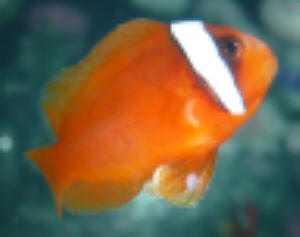 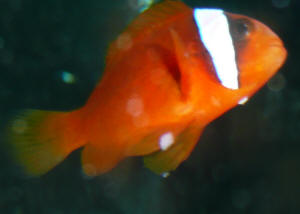
|
Clownfish - possible fungus, Lined Wrasse comp. 5/1/08
Hello! I have a fairly new 29 gal FOWLR tank (4 weeks). Water
parameters are great. I incorporated a small Ocellaris clown initially,
then two weeks later a 6 line wrasse. I noticed almost immediately
after I got the clownfish some white spots on his fin. Could have been
there when I got him but it was hardly noticeable. Originally I thought
it was a stress-induced secondary infection, or perhaps that he had
been picked on in the LFS tank. Upon closer inspection, the bottom of
the fin is feathered and ragged and there are some white, almost fuzzy
areas. There has been little change over the past 4 weeks but it
definitely isn't going away... maybe getting a tad worse. The fish
seems totally healthy otherwise, eats, swims, sleeps normally and is
energetic. I wondered if the wrasse was harassing it <Could well
be... in such a small volume... this species can be a terror>
however I have never noticed that type of behavior. I thought of
treating with some MelaFix <Worse than worthless... may well upset
the cycling of the system, alter pH... of no medicine value> but I
am afraid of harming my beneficial bacterial. <You are wise here>
Any suggestions? <Patience, observation... possibly the removal of
the Wrasse. Bob Fenner> Melissa L. Hetzer
Sick Clownfish: 4-28-08 Hello, I am in
need of some advice. <Allright.> I have a 20 gallon fish only
tank containing only a pair of clown fish. When I first brought these
fish home they behaved normally for about a week. Then the larger one
(the female I assume) stopped eating, was breathing rapidly and would
occasionally lie on the bottom of the tank. Even though there were no
other symptoms I guessed that it was either ich or velvet and I had
caught it early. <Ich or velvet would produce other symptoms like
increased mucus or white specks along the body. If these were not
present I doubt it was either of the two.> I did not plan on ever
having any coral or other reef creatures so I decided to treat the
whole display tank with CopperSafe according to the instructions. After
another two weeks went by, the larger clown was doing very well. It
stopped the rapid breathing and started eating normally. (The smaller
clown always looked and behaved normally, and that never changed) It
has been about a month since the start of the copper treatment and the
large clown has had a large appetite and is relatively active. <Have
you done any water changes since then? Let me stress that treating in
the main display is never recommended. As you subjected the other
healthy clown to medication that it did not need. That can cause
adverse side effects in the long run. Always medicate in a quarantine
tank. > But three things still bother me. First, when the large
clown first became sick, it lost its color. The color never returned to
normal. It is pale compared to the smaller clown. <Pale color can be
a lack of nutrition and poor water quality. What kind of foods are you
feeding?> Second, the large fish will still sometimes lie on the
bottom of the tank (especially at night), but immediately wakes up when
anyone goes near the tank. <This may be it's sleeping spot. Are
you providing any shelters for it? Ie: rocks, pipes. Also are the male
and female sleeping together or separately?> Third, recently very,
very faint spots have appeared on the body of the fish. There are three
of these spots and they are faint enough that they can only be seen in
the right lighting. I have been watching these spots for about a week
now and they have not changed. <Raised spots? Let me ask
this'¦Do you notice any aggression between the two fish? Were
they bought as a mated pair? Perhaps these can be injuries from
fighting.> My question is, should I continue copper treatment until
the large fish behaves and looks completely normal? Or is the odd
behavior and spots caused by something else like a fungus or bacteria
that copper cannot treat? I have been testing the water quality
constantly during the whole process. The ammonia/nitrites both have
been zero, and the nitrates have been very low <0.5 ppm. <I would
stop the copper as soon as possible and do a good water change on the
tank. I think that pristine water and a good nutritional menu will help
the clown get back on the right track.> Another quick question I
just thought of. The pair of clownfish will "vibrate" at one
another. Is this normal behavior for a clown fish? <Yes, it is not
too abnormal. When this occurs, do you witness any submissiveness from
either of the two? Is this a mated pair?> Thanks for your help.
<Not a problem. --Yunachin> -Ethan
Sick Clownfish? 04/28/2008 Hello, I am in need of some advice.
<<Hello, Andrew today>> I have a 20 gallon fish only tank
containing only a pair of clown fish. When I first brought these fish
home they behaved normally for about a week. Then the larger one (the
female I assume) stopped eating, was breathing rapidly and would
occasionally lay on the bottom of the tank. Even though there were no
other symptoms I guessed that it was either ich or velvet and I had
caught it early. I did not plan on ever having any coral or other reef
creatures so I decided to treat the whole display tank with CopperSafe
according to the instructions. <<Ok>> After another two
weeks went by, the larger clown was doing very well. It stopped the
rapid breathing and started eating normally. (The smaller clown always
looked and behaved normally, and that never changed). It has been about
a month since the start of the copper treatment and the large clown has
had a large appetite and is relatively active. But three things still
bother me. First, when the large clown first became sick, it lost its
color. The color never returned to normal. It is pale compared to the
smaller clown. <<Should return in time given a staple
diet>> Second, the large fish will still sometimes lay on the
bottom of the tank (especially at night), but immediately wakes up when
anyone goes near the tank. <<Quite normal, most clowns will act
"odd" sometimes>> Third, recently very, very faint
spots have appeared on the body of the fish. There are three of these
spots and they are faint enough that they can only be seen in the right
lighting. I have been watching these spots for about a week now and
they have not changed. My question is, should I continue copper
treatment until the large fish behaves and looks completely normal?
<<Could be either really. try taking a look at the following page
including linked articles and FAQ's.
http://www.wetwebmedia.com/clnfshdisart.htm >> Or is the odd
behavior and spots caused by something else like a fungus or bacteria
that copper can not treat? I have been testing the water quality
constantly during the whole process. The ammonia/nitrites both have
been zero, and the nitrates have been very low <0.5 ppm. <<Do
please read the above linked article to pin point your clown fish
"spots". >> Another quick question I just thought of.
The pair of clownfish will "vibrate" at one another. Is this
normal behavior for a clown fish? Thanks for your help. -Ethan
<<Yes, very normal indeed>> <<Thanks for the
questions Ethan, hope this helps. A Nixon>.
|
Urgently need help - unidentified clown fish problem.
Env. 4/7/08 Hi Guys, <Carolyn> Really need
your help - my 70l (18 gallon) tank has been set up since
February 2008 with live rock, and has been fully cycled for 5
weeks. Current readings are ammonia 0ppm, nitrite 0ppm, nitrate
3ppm.Temp is 25-26 Celsius (77-78.8F), SG is 1.024. The tank is a
mixed system with a clean up crew (hermits, snails, one skunk
cleaner shrimp), zoas, 1x Duncan coral, 1x branching hammer
coral, <... all this disparate Cnidarian life cannot be
introduced into such a small volume this quickly...> 1x pussy
coral, 1x Sinularia and some mushies. <...> Fish-wise, we
added our first fish, a Randall's Shrimp Goby 4 weeks ago and
he is absolutely fine, is a tad timid (he lives in the live rock
and comes out to feed). Addition number 2 was a coral beauty,
she's also fine and was added 3 weeks ago. The readings were
monitored daily to ensure all was fine, all readings were 0
(nitrate only gone up this week). We then added two small (about
1") ocellaris clowns, from a different LFS as they were the
only ones we could find that were tank bred. They'd been in
the shop, in quarantine for 3 weeks, before being put on sale.
Both looked fine, but there was a larger clown looking a bit
ropey <Ropey? Am not familiar with this term> (I know, at
that point I should've walked away). We acclimatised the fish
as before, dripping tank water into the bag over 1.5hrs once the
water temp had reached that of the tank. <Mmm, better by far
to isolate/quarantine for a few weeks> Both fish immediately
chose the branching hammer coral as "home"! <Not
atypical... and not likely tank-bred...> They were fine until
3 days later, when we noticed a coating of mucus on both fish but
on one side only - mostly on their dorsal fins, which weren't
held up as normal, their flanks and some on their faces. One was
more badly affected than the other, so I did some reading and
researching, coming to the conclusion it could be either
Brooklynella or that they were being stung by the coral. <Much
more likely the influence of the latter> As we had no formalin
we did an emergency freshwater bath on both clowns, for 20mins.
Both were fine and were clear of mucus for another 3 days, then
the mucus was back but worse, one of the clowns looked like its
gills might be ragged/inflamed, hard to tell as he was swimming
round and seemed to be more agitated than normal. Both were
eating fine. We did a second FW bath, 20mins, however the fish
seemed a lot more stressed this time - on returning them to the
tank both flopped to the bottom, breathing rapidly and looking
very unsteady. After about 30mins the least poorly fish was
swimming round (albeit a bit wobbly still), but the second was
gasping and not swimming. Another 30mins passed and the first
fish was now ok, but the second one was dead. Having asked yet
more questions of LFS's, the web and forums, I'm
wondering if this could be velvet? <Mmm, no> The remaining
clown is in QT again, raised the temp to 27-28 Celsius (80-82.4
F) and dropped SG to 1.019. She's looking better this morning
and is easting and swimming fine. Both remaining fish in the main
tank look fine, no symptoms at all (although catching the goby
would be impossible, am considering a FW bath for the coral
beauty as a precaution?). <... I would not and a Centropyge
(bispinosus or otherwise) cannot live/well in such a small
volume> If you think it is velvet, will copper treatment in QT
help, or is it enough to use hyposalinity and raised temp?
<... This issue is very likely almost to entirely
environmental... the stinging-celled life...> Next..! We want
to add a new clown, <Mmm, no> however don't know
when's best. One suggestion is to add him to the QT with the
other, treat both with copper to eradicate an ich/velvet etc,
then do a formalin dip on both immediately prior to adding to the
main tank, although this seems very stressful for them?
Alternative is to keep fish 1 in QT for 2-3 weeks, treat with
copper, then add her back to the display tank (how do you make
sure no copper is inadvertently added to the main tank?!), adding
fish 2 to QT for 4 weeks before adding that one to the main tank.
Am concerned about them fighting as fish 1 would have made a
territory. It's still very small (about 1"), so any new
addition would most likely be larger. Really don't know what
to do for the best? <Best to just wait at this point... for
your present organisms to mature, learn to live with each other
for a few to several months> Any help you can give would be
gratefully received - I have learned the hard way about how vital
a QT is, even if its only a small one like mine (13 litres!).
Many thanks, Carolyn <Please read here:
http://wetwebmedia.com/cnidcompppt.htm re Cnid. comp....
reduction of negative interactions, their effects. Bob Fenner>
Re: Urgently need help - unidentified clown fish problem...
env. 4/7/08 Dear Bob, <Carolyn> Thanks for
the reply and advice - much less-than-accurate info had been
given, I shall now be avoiding that LFS in the future. <Best
to vote with ones shoes... walk on that is... Now if we could
only do this with the confiscatory practices of our
gov't...> Have taken your advice on board and are
<am> leaving the tank as it stands - the plan is to upgrade
in the next 6 months to a much bigger tank (approx 200-300L),
using our current one as a QT (hence why I was happy to add a
dwarf angel, knowing she'll be going to a much more suitable
size tank in the very near future). <I'd hold off till the
new tank is well in-place, established> Thanks again for the
help and the site - intend to spread the word about WWM to
friends who also keep fish :) <Ahhh! A pleasure to share.
BobF>
|
|
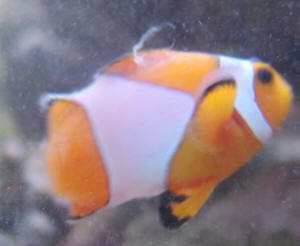
|
|
No clowning around (like I'm sure I'm the first to
come up with that) 03/30/2008 Hi crew, <<Hello, Andrew
here> On a serious note. I've been trying to match what my
clown is sick with on WWMedia and the rest of the web. And I
figure it's Brooklynellosis. The fish cannot stay balanced
(fish's nose is down and tail up, he can't stay
horizontal) and white stringy feces, which typically lead me to
believe bacterial (although could be secondary infection). I have
attached 2 pictures. Hopefully they are clear enough. Water
parameters in quarantine (hence the bare bottom tank): NH4, NO2,
NO3 all undetectable, pH 8, salinity 1.024, temp 78F, tested
everyday and 10% water change everyday up until antibiotic
treatment (read further). He's been in quarantine for 5 days.
Freshwater dip prior to QT for 10 minutes. Day 2 laboured
breathing, never ate, just picked and spat out. Lethargic day 4,
day 5 swimming head down (lost balanced), and few hours ago the
white speckles (perhaps peeling slim coat, not really sure).
Also, I haven't seen any sort of flashing. I'm not really
a fan of organic chemicals (or anything poisonous) for what
should be a non-toxic hobby for all (animals and humans). As a
geneticist, I am well aware of the hazards and would be fully be
protected in my own lab (gloves, fume hood? etc). Contrary to my
beliefs, after seeing his condition, I gave him a formalin bath
as per WWMedia recipe (1 minute); Along with maracyn2 in
quarantine tank. I'm at my wits end and hopefully I
haven't caused more damage. I'm hoping you could
positively ID his condition and course of treatment, as I'm
sure he's a goner (but I won't give up). I'll at
least be able to recognize it again and treat sooner. If he is
still alive in the morning I'll be hopeful of a positive
outcome. <<Unfortunately, I really cannot make much out
from the attached pictures to make a diagnosis. Either submit in
focus photo's or have a read of this page and attached
articles and FAQ's
http://www.wetwebmedia.com/clnfshdisart.htm >> Thanks in
advance. <<Thanks for the questions, hope this helps. A
Nixon>>
Re: No clowning around (like I'm sure
I'm the first to come up with that), Dimilin in dips --
04/1/08 I had looked at that link (many times), couldn't
make any inferences. Unfortunately the clown died the day before
yesterday. He had no tail left, think he suffered too long and
was beyond return. <Agreed> Just before he died I dosed the
QT with Jungle Parasite clear (Praziquantel, Dimilin,
Metronidazole, Acriflavine). I really wanted just Metronidazole
but I couldn't get any at the time and picked up the
mentioned out of desperation. Which leads me to my question. In
the dip/baths section, Bob is completely against using Dimilin in
marine systems. <Mmm, not efficacious as a dip ingredient>
Why is this so (especially if there are no inverts ie.. QT. I
figure its just as bad as Cu++ meds, formalin...etc.)? <...
bad? No... just that acetylcholinesterase inhibitors in low
concentration don't do any good in short exposure> I could
have sworn I also saw a post with Bob recommending it for marine
(although I can't find it anymore). Could you explain the
contradiction (that is if there was, did his opinion change over
time?). <Not w/o ref. to where this is stated, no> Lastly,
I assumed I had a parasitic infection as upon dosing the QT, the
clown moved erratically. Presumably because the parasites were
affected. <... what parasites? Do you have microscopic
evidence?> It could have been just from the clown reacting to
the meds but something (which I can't articulate...you had to
see the clown) seemed the parasites were moving to get away and
burrowing in him further. Thanks <... BobF>
Re: No clowning around (like I'm sure
I'm the first to come up with that) -- 04/02/08 I do not
have microscopic evidence. It was just an inference on an
observation with out proof - merely a feeling (true, not
scientific at all). <I see... do know this sort of guessing is
not altogether accurate. There are symptoms that
"mimic" pathological disease... with
non-infectious/parasitic etiologies... Too often
"marks", abrasions, "odd" behavior are rooted
in social, environmental, nutritional, genetic... causes> I
just like to know if you would recommend/use Dimilin in marine QT
(not dip but in the QT) and under what circumstance? If not, why?
Thanks <I have used, and suggested such use for arthropod
zoonoses... on bony fishes (not cartilaginous). IF one was sure
of a copepod infestation let's say, Dimilin might be a good
choice. BobF>
|
|
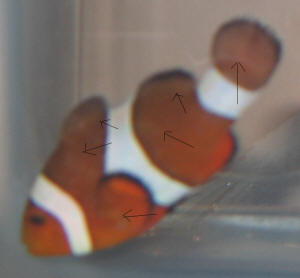
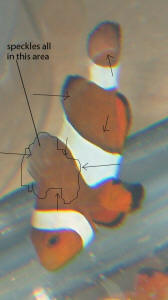
|
Red Spot on Clownfish, using WWM --
03/18/08 Hello Crew. I will make this fast. I cannot find this
anywhere in the faq's. I have two tank raised clowns and the one
seems to have a red spot on the side of its mouth. It almost looks like
blood. It is raised also. It is about in the area where a white spot
once was and has disappeared. My param.s are: pH = 8.2 Ammonia = 0
Nitrites = 0 Nitrates = 20ppm (just did a water change 30 min.s ago)
<Too high...> phosphates = 1.0 ppm <Ditto> What in the
world could this be? Should i be concerned? The fish is still eating by
the way. Thanks a million for all of your help Matt <Go here:
http://wetwebmedia.com/WWMAdminSubWebIndex/question_page.htm
insert your title: "Red Spot on Clownfish"; read the cached views. RMF>
|
|

